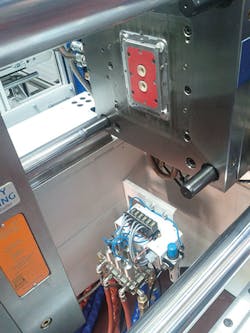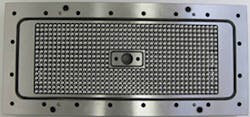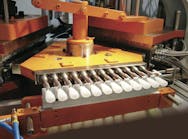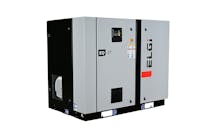Keeping the surface of the mold hot during plastic injection then rapidly cooling it after the cavity fills is an evolving process with advancements in the induction, steam and water technologies that drive it.
Dynamic mold temperature control technologies that rapidly raise the mold wall temperature above the polymer's glass transition temperature during the mold-filling stage are finding acceptance in larger markets from consumer electronics to automotive and aerospace. The technologies that allow for the rapid mold temperature change are diversifying the types of materials — now thermoplastic composites and metal injection molding — and applications — such as automotive interiors and airplane seats.
Unlike traditional molding in which a frozen skin layer of material forms when the molten polymer comes in contact with the relatively cooler surface of a steel tool, cycling the mold temperature is proving its ability to improve flow lengths, attain a resin-rich surface even with foamed or reinforced materials, lower injection pressure and clamping requirements, and reduce internal part stress.
RocTool, a supplier of internal and external electromagnetic induction technology based in Le Bourget-du-lac, France; Gas Injection Worldwide Ltd., Winsford, United Kingdom, developer of rapid temperature technology using saturated steam; and Wittmann Battenfeld Inc., Torrington, Conn., licensor of a special pressurized water and ball-filled tool technology, report their recent developments.
3iTech
INDUCTION TECHNOLOGY GOES BIG
Ju Teng International Holdings Ltd., a Taiwan-based provider of computers, communication and electronic (3C) devices, this year signed two new production licenses with RocTool for its 3iTech (Integrated Internal Induction Technologies) internal electromagnetic induction technology, one for the manufacture of injection molded touch tablet parts, and a second for molding laptop/notebook cases. It will produce less than 0.5 mm thick tablet parts from reinforced thermoplastic resins. Ju Teng is said to hold a 30 percent market share in the global notebook casing market.
The company purchased a 3iTech production license from RocTool in 2013 for the production of smart phone parts made from thermoplastic composites. It has manufactured over a million smart phone parts in the last quarter of 2013 at its Suzhou, China, plant -- considered the largest composite factory in the world-- and continues to produce one million such parts each month.
Ju Teng is producing the smart phone, tablet and notebook parts at the $10 million production plant it constructed last year in China that houses 100 production lines where each line is fitted with RocTool technology, says Mathieu Boulanger, president of RocTool Inc., a U.S. subsidiary based in Charlotte, N.C.
Expliseat SAS, a Paris-based manufacturer of aircraft interiors, licensed 3iTech in 2013 to develop and produce thin-walled hollow-tube composite structural seat parts for an airplane seat that is half the weight of competing designs. The United States Federal Aviation Administration this year said the lightweight 4kg (8.8 pound) seat meets all safety standards and is approved for use in the U.S. and around the world. There are 30 patents related to the aircraft chair, made from titanium and composite material, and comprised of 30 parts compared to 300 parts for a conventional aircraft seat.
Motorola Mobility developed two back covers from a thermoplastic composite for its MotoX and Ultra line of smart phones using RocTool 3iTech induction technology. Use of the technology provided high surface quality and high speed production, allowing for the manufacture of more than 50,000 units per day. RocTool won the 2014 JEC Europe Innovation award for Aircraft Interiors and for Consumer Electronics for the Expliseat and Motorola Mobility projects.
RocTool says its 3iTech and CAGE induction technologies offer better heating speed, higher energy efficiency, greater temperature distribution and a high temperature level than competing rapid tool heating approaches. RocTool generally can heat a tool surface in 3 to 10 seconds up to a maximum temperature of 842 degrees Fahrenheit (450 degrees Celsius). Cooling water is generally run at approximately 104 degrees Fahrenheit (40 degrees Celsius), says Boulanger.
In 2012, RocTool commercialized a two-step process with 3iTech to form thermoplastic composite and plastic together in the same induction mold without the use of an infrared oven or pre-consolidated sheets. This approach improves part performance, eliminates a post-curing step and achieves high part surface quality and weight reduction, while generating high production rates.
RocTool's approach can also be applied to thermoset composite part molding, where it can fast-cure while eliminating the need for a post-cure step, and it can reduce cycle times (to 5 to 7 minutes depending on the part). A German automotive part maker is using Trexel's Mucell technology with RocTool induction to produce piano black bezels with no sink marks.
Seven of the 40 licenses issued by RocTool for its 3iTech interior induction and Cage external induction technology are in the U.S., says Boulanger. Cage heats by generating a direct electromagnetic field that surrounds and penetrates the mold surface.
With 3iTech the magnetic field and electromagnetic current is generated in a channel in the tool, and then by conduction the tool surface is heated, says Boulanger. Both internal and external induction technologies raise mold surface temperature up to 77 degrees Fahrenheit (25 degrees Celsius) per second. A temperature sensor in the tool signals a change to the mold temperature, says Boulanger.
GIWW
FULL STEAM AHEAD
Gas Injection Worldwide (GIWW) Ltd. updated its Rapid Temperature Cycling (RTC) line of Steam Heating and Water Cooling (SWC) units in 2012 with a new integrated high pressure steam boiler designed to generate up to 35 bar steam pressure.
The integrated electric steam boiler, called the SHC controller, is offered in models from 48 kW to 240 kW, and generates steam at temperatures up to 473 degrees Fahrenheit. Typical mold heating times are from 6-20 seconds depending on the mass of steel to be heated (mold size), says Raymond Foad, sales director at GIWW.
Latent heat energy contained in steam is more than six times greater than the latent energy contained in water at the same temperature. In a presentation, Foad demonstrated the SWC system heating a mold in a 200 ton injection press from 122 degrees Fahrenheit to 248 degrees Fahrenheit (50 to 120 degrees Celsius) in six seconds, then cooling it back to 122 degrees Fahrenheit in another 10 seconds. GIWW's system delivers pressurized steam into conformal heating and cooling channels within the tool to rapidly heat the mold surface. The steam is subsequently evacuated by compressed air and is followed by water cooling, all controlled by the SWC system.
Saturated steam technology is now replacing superheated steam and pressurized water systems in the consumer electronics markets in greater numbers, says Foad. OEMs such as Samsung and LG Electronics are using GIWW systems for large (65 inches) LED TV bezels and rear panels, where energy savings, higher production rates and excellent surface finish are the benefits, says Foad.
Steam technology is attracting more automotive projects looking to lightweight parts, says Foad. Molders have a possibility to down-size the wall section of the part, which can also reduce required molding pressures.
Wittmann Battenfeld
WATER-BASED MOLD TEMPERING
Wittmann Battenfeld has offered its BFMold (ball filled mold) rapid heating and cooling mold technology for use with its Battenfeld line of injection presses for three years, and has one installation in the U.S. with several others in testing there, says Wes Moffitt, regional sales manager, auxiliaries. There are 11 installations globally with 18 other projects worldwide that are in a testing phase.
Wittmann Battenfeld has developed a new temperature control unit with more heating and cooling power for its BFMold technology.
"We've designed the interface to allow the operator to make all necessary adjustments to BFMold through the injection machine rather than through the temperature control unit," says Moffitt. An additional programmable I/O card improves the synchronous operation between injection unit and temperature control unit. BFMold works with water and can heat the tool surface at a rate of 45 degrees Fahrenheit per second up to a maximum temperature of 356 degrees Fahrenheit.
Wittmann Battenfeld is raising the profile of the BFMold technology, showcasing it at an open house last May with a presentation on capabilities and component developments. BFMold presently appears to work better with amorphous materials rather than crystalline resins.
The BFMold technology replaces the cooling channel circuit that courses through a mold, instead utilizing the entire volume of space that exists below the cavity structure. The entire void beneath the cavity is filled with steel balls.
The ball-filled space is then filled with water that is conditioned by its new Tempro plus D Vario 180 pressurized water tempering unit. The unit, designed for BFMold, provides direct heating and either indirect or direct cooling for flow temperatures up to 356 degrees Fahrenheit. The valve switching unit mounts close to the mold in order to keep the hose volume to a minimum, ensuring fast thermal changeover from a hot to a cold medium. The microprocessor controller is accurate to +/- 0.2 degrees.
Mikell Knights, senior correspondent








